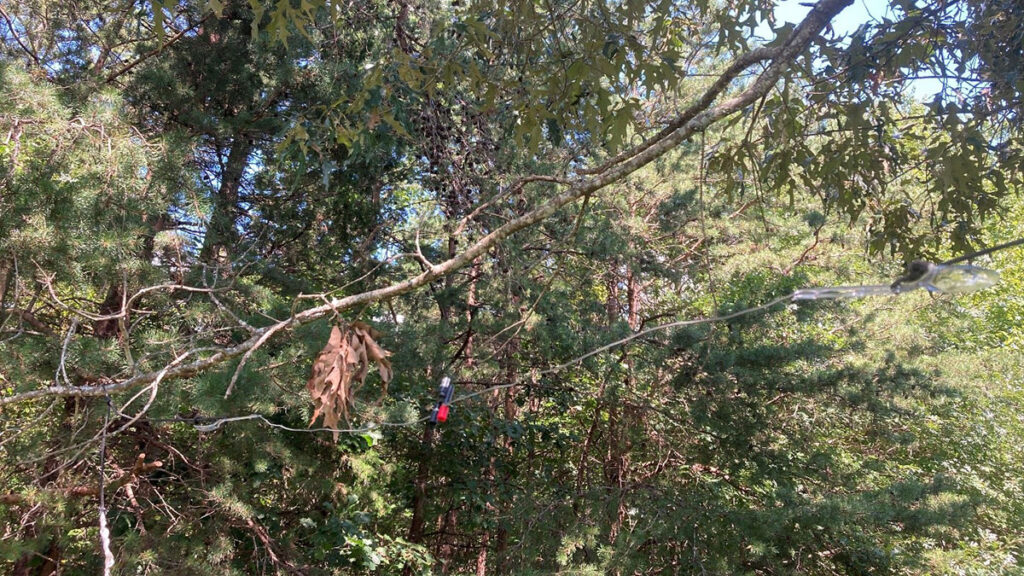
I’ve been fiddling round with making antennas a little bit of late, and in case you’re model new to ham radio and have shortly found the significance of the antenna together with your potential to each obtain and transmit, you’ve in all probability begun to marvel a bit about what it takes to make your individual antennas as nicely. If that is the place you end up, one of many best antennas which you could construct is named a dipole antenna.
I’ll present you the way I made one (actually out of rubbish) for my Baofeng UV-5R. It could provide the inspiration you might want to attempt to sort out making your individual.
Let’s Say You Simply Handed Your Technician License
Which means you now have authorized entry to transmit on the 2m and 70cm bands (extra data on technician license). The place I dwell, it appears as if many of the visitors that’s out there may be within the 2m band quite than the 70cm. In case you dwell in a rural location, this is sensible. The 2m band does a significantly better job of touring distance over rural places than does 70cm. (In distinction, 70cm does a greater job of touring in city places via buildings.)
Due to the place I dwell, I wished to construct an antenna that was made particularly for the 2m band. Inside this band, you have got authorized permission to transmit from 144-148 MHz with a novice radio license. I arbitrarily determined that I used to be going to make my dipole particularly for 146.000MHz. It’ll nonetheless work all through 144-148MHz too, although.
To do that, you’re first going to want some tools. After I was beginning this construct, I wished to exhibit which you could actually make an antenna out of absolutely anything. If you end up in a WROL collapse scenario, you aren’t going to have entry to Amazon or Gigaparts. You will have what you have got round you and that’s it. But when you know the way to make use of what’s round you, you may simply craft an antenna out of rubbish.
That’s what I did right here.
What You Want
The one necessities that it’s important to have beforehand is a cut up publish BNC adapter, an adapter, your coaxial cable, and your radio.
For the radio, I used the Baofeng UV-5R as talked about above. This appears to be the inventory “prepper” radio, everybody has one, and if you find yourself in a post-Hurricane Katrina sort occasion, these are the radios that you just’re liable to see popping up all through the group.
Hooked up to that, you’ll have an adapter that’s SMA feminine on one facet and BNC feminine on the opposite facet. It will assist you to connect to the cabling I’m going to debate beneath. BNC adapters are good as a result of you may detach them out of your radio shortly, and then you definately don’t have to fret as a lot about breaking the SMA male adapter that’s inside your Baofeng UV-5R.
For the coaxial cabling, I used this right here. It’s a BNC male ending on either side. I used a 25’ size of cable, which isn’t best, nevertheless it’ll work simply fantastic. To my understanding, as soon as the cable goes past 19’, you start to lose a few of your “juice” in your transmissions. The radio should work more durable to “pump” the sign down a brilliant lengthy size of “pipe” and it weakens the sign. So, don’t purchase a 50’ cable.
On the reverse finish of that coaxial cable is that this cut up publish BNC adapter. Take into account that it is a BNC feminine cut up publish BNC adapter. If you find yourself shopping for a male model, you’re going to be very disillusioned once you go to set every thing up and speak together with your buddies, solely to find that you just really can’t connect with your antenna in any respect.
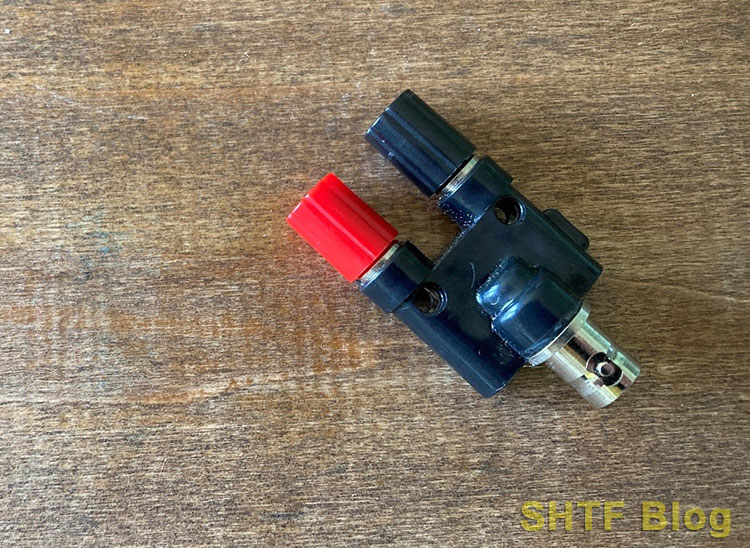
So, These Are the Necessities. What Concerning the Trash?
You’re going to want two lengths of wire, two items of cordage, and two insulators. That is the world the place you may get artistic.
The opposite day, I used to be mowing my garden once I someway ran over a bit of the electrical fence that was going round one in every of my gardens (don’t ask). After about half-hour kneeling within the filth with a pair of wire clippers, I had loads of scrap wire for my antenna construct. That occasion was the inspiration for this text.
My two items of cordage suffered the same destiny. I used to be utilizing a protracted size of paracord to connect to azalea bushes to tug out of the bottom with my truck. I pulled one azalea out after which shredded the paracord to items trying to tug out the following. The tangled mass of frayed cordage ended up being recycled for this antenna.
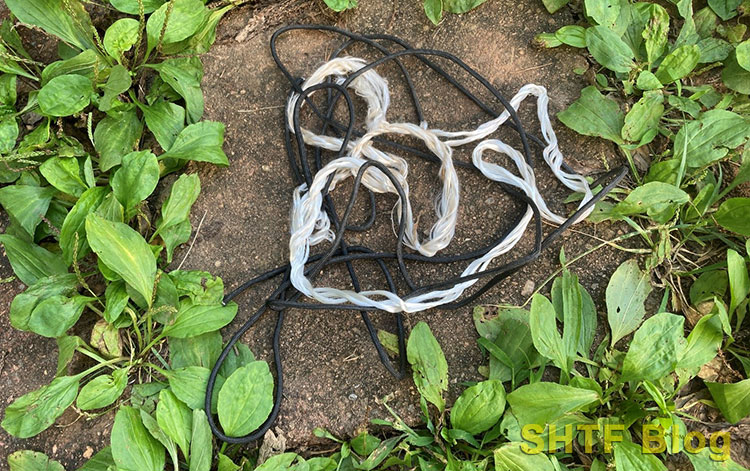
For my insulators, I used plastic spoons. Each survival handbook I’ve ever seen that discusses emergency communications at all times appears to have an image of a plastic spoon getting used as an insulator. That being the long-lasting “Oh crap, I would like an insulator!” merchandise to me, that’s what I made a decision to make use of.
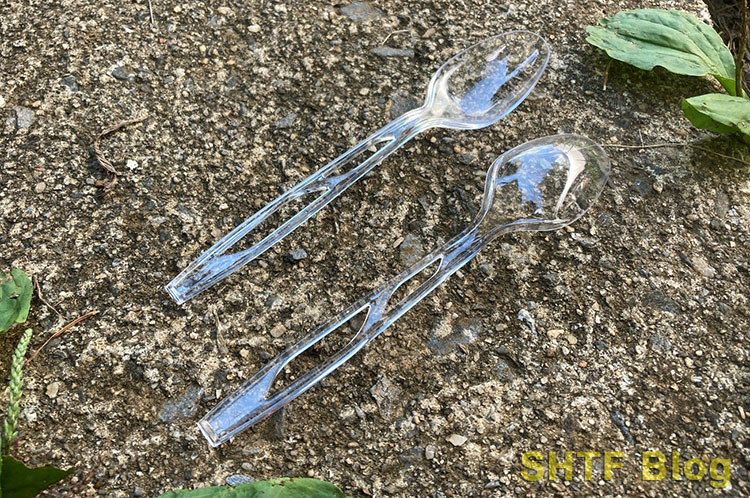
Slicing the Wire to Dimension
I needed to do a little bit of math on this. So, with a dipole, you have got a size of wire that’s connected to every publish on the cut up publish BNC adapter. I wished every of those lengths of wire to be 1 / 4 of a wavelength lengthy.
Do not forget that I mentioned I wished my antenna to be for 146.000 MHz? Due to that finish objective, every size of wire wanted to be 1 / 4 size of a 146.000 MHz wave.
To calculate this, I used the next formulation:
1 / 4 wavelength antenna size in ft = 234/the frequency I’m utilizing
So on this case, I took 234/146. That gave me a solution of 1.6027 ft. Okay, so I do know I have to make every size of wire 1.6 ft lengthy. Being academically lazy, I plugged on this determine to a conversion calculator on-line. It informed me that 1.6 ft is nineteen.2”. That implies that every size of wire must be 19.2”. DON’T CUT YOUR WIRE TO THAT LENGTH, HOWEVER.
I’ll inform you why. It’s essential to give your self some wiggle room. You’re going to have to connect that wire to an insulator on one facet and a cut up publish BNC adapter on the opposite. That requires just a little additional wire to take action. I gave myself an additional inch on either side to work with. Which means I lower every size of wire to 21.2” utilizing a pair of wire cutters.
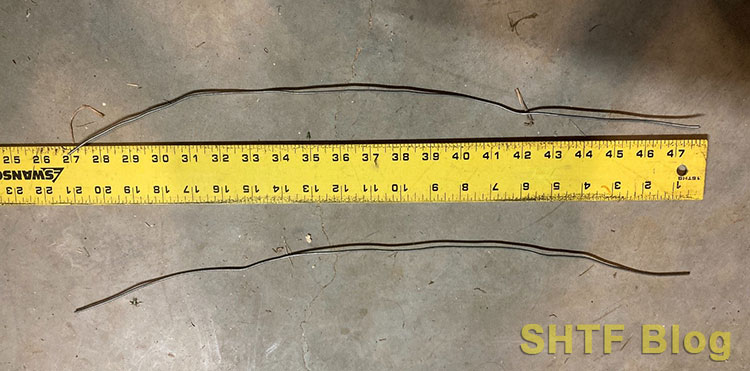
Subsequent, I used a pair of needle nostril pliers to bend either side of the wire right into a small hook. I attempted to make use of an inch of fabric to make every hook. There’s a bit {of electrical} engineering concerned within the ‘why’. Your wire could embody 21.2” of fabric, nevertheless it’ll behave like a 19.2” wire if it’s bent to be a 19.2” wire. So, if I bend an inch of fabric on either side, the electrical energy that flows via the wire will nonetheless “assume” it’s a 19.2” wire.

After making the hooks, I unscrewed the pink and black caps of the cut up publish BNC adapter a bit and hooked one wire on one and the opposite wire on the opposite. To make the hooks wish to keep in place, I squished them with a pair of pliers. Then, I tightened again down the pink and black caps. This made every thing keep in place on the cut up publish BNC adapter and made it in order that I had what appears to be like like a protracted metallic strolling stick.

I then wanted to connect my insulators – my spoons. Fortunately, my spoons already had holes within the handles of them. I put a hook of the wire via one in every of these holes within the spoons on each sections of wire and squished it down with pliers once more in order that it might maintain onto the spoon. My insulators had been now connected.
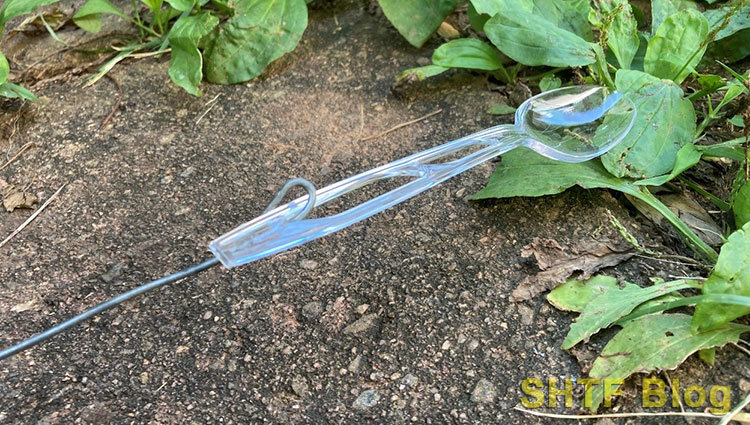
Get it Up Right into a Tree
Do not forget that Paracord I used for my azaleas? That’s the place this got here in. I lower the Paracord into two items and tied a size of it to every spoon. Then, I tied one piece of Paracord to a tree, stretched out my antenna, and tied the opposite size of Paracord to an enormous department. The result’s a wire hanging up off the bottom, parallel with the bottom.
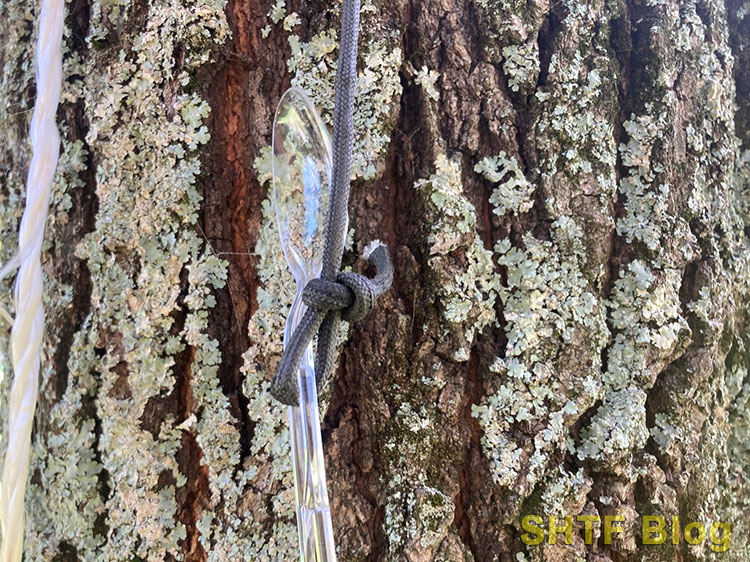
On this case, my complete setup was about 8’ into the air, so I used to be nonetheless in a position to attain it and fasten the BNC coaxial cable to it and not using a downside. In case you’re going to hoist your antenna up method excessive within the air, you’re going to wish to have your BNC coaxial cable connected earlier than you achieve this.
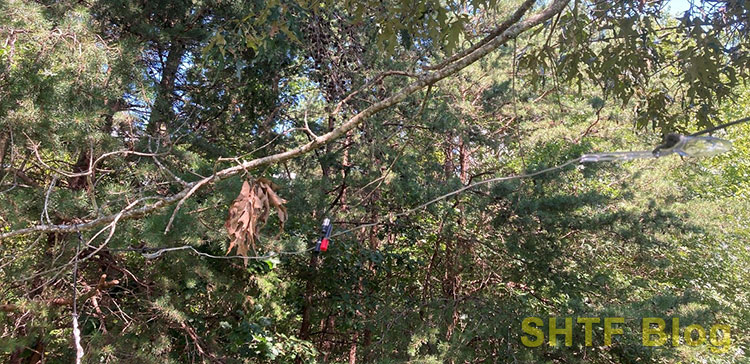
The very last thing that I needed to do was to attach the opposite finish of the cabling to my Baofeng UV-5R. Piece of cake. I now had a dipole antenna strung up right into a tree that was usable. One of many essential issues to recollect anytime you’re working with VHF is that you just’re working line of sight. That implies that the upper up your antenna is, the higher in a position it will likely be to “see” different radios. This implies which you could sometimes get out crisper transmissions and obtain clearer alerts the upper your antenna is.
The place I dwell, the vegetation is dense, and every thing is hilly. This was one factor that’s routinely given me issues with decrease antenna setups. I used to be in a position to eavesdrop on another man’s transmissions, however my very own had been very staticky.
To fight this, I set the dipole antenna up on my entrance porch. It’s a lot larger floor there than the place I had it within the tree, and a clearer line of sight is current. I additionally oriented the antenna in a distinct route this manner as nicely.
Whereas a dipole antenna is an omnidirectional antenna – that means it each receives and transmits in all instructions – it doesn’t transmit very nicely from the ideas. So, in case your buddy on the opposite facet of city is at a bearing of 270 levels and your dipole antenna is pointed straight at him, you’re not going to get an excellent transmission his method, if in any respect. You will have to swing your dipole out broadside to him to get the perfect outcomes.
By my mounting the dipole between two helps of my porch I used to be in a position to transmit out to an area repeater for a web that was happening, however my transmissions had been fuzzy. The repeater was a good way away and I used to be solely transmitting with 5 watts of energy (not quite a bit), so my transmissions out nonetheless weren’t nice, however the reception was implausible.
After taking just a few days to assume over this downside, I found that I’d made a rookie mistake. All VHF communications (aka, the 2m band) are FM. All FM alerts make the most of vertically oriented antennas. I’d arrange my dipole horizontally. That’s why my transmissions had been rubbish. You lose one thing like 20 dB of achieve, that means that your transmissions are going to exit very weak. That’s what was occurring to me.
The opposite factor I might extremely suggest is investing in an SWR meter in case you’re going to construct your individual antennas. I didn’t use one for this construct (I do know, I do know), however it can hold you from burning up the center of your radio and rendering it a brick in case you make a mistake in your antenna construct.
Making a Dipole Antenna is Straightforward
As you may see from above, you may actually make an antenna out of trash and achieve success with it. As at all times, there are going to be variables that you’re going to need to keep in mind (distance, energy ranges, geography, and so on.), however simply realizing just a few easy antenna builds in addition to prepping the mandatory adapters and coax beforehand offers you an enormous profit in a catastrophe scenario over the man who simply purchased a bunch of UV-5Rs and threw them right into a field in his basement for when the crap hits the fan.
Whereas he’ll have the power to transmit a sign, it received’t be wherever close to the gap that you may be able to, and also you’ll have the data and skill to know the way to make your individual antennas even when issues break (and they’re going to).
So, seize your self the mandatory gear and get out and begin experimenting with these items. It’s a heck of a number of enjoyable, you’ll be taught quite a bit, and also you’ll bolster your preparedness ranges.
What are your ideas on all this? Have you ever ever constructed your individual antennas? Do you have got every other recommendation? Tell us within the feedback beneath.

